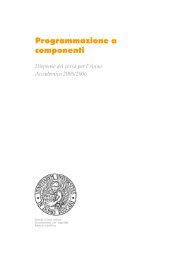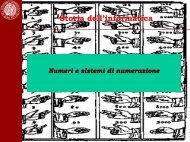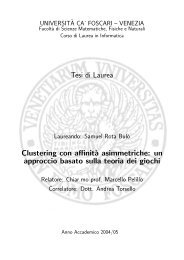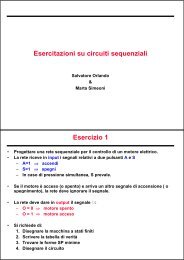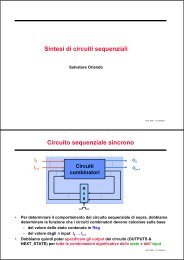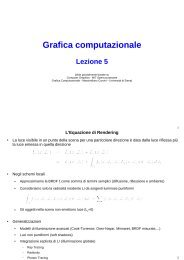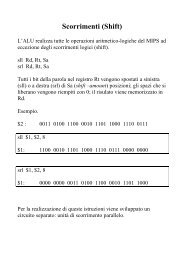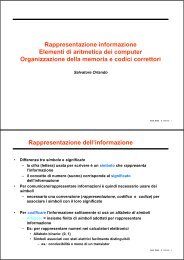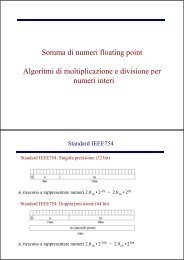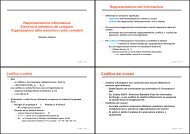Foscari - Dipartimento di Scienze Ambientali, Informatica e Statistica
Foscari - Dipartimento di Scienze Ambientali, Informatica e Statistica
Foscari - Dipartimento di Scienze Ambientali, Informatica e Statistica
Create successful ePaper yourself
Turn your PDF publications into a flip-book with our unique Google optimized e-Paper software.
13. to communicate ideas or feelings in<strong>di</strong>rectly – _______________ (para 10)<br />
Emoticons, emails and letter writing<br />
Simon Jenkins<br />
September 21, 2007<br />
Have emails made us into unemotional machines?<br />
The emoticon is 25 years old. In 1982, a Pittsburgh professor, Scott Fahlman, noted that his students’<br />
emails lacked body language and voice tones and could not express greetings and humour. So, the<br />
smiley was born, and with it a large amount of symbols intended to insert normal human emotion into<br />
the cold alphabet. A–Z might have been fine for Shakespeare, Milton, Keats and Shelley, but for<br />
today’s global nerd it is not good enough.<br />
Early telegraphy had its own short forms and users soon realized that abbreviated language could<br />
sometimes cause unintentional pain and embarrassment. Therefore, symbols were used to soften<br />
remarks that might seem sarcastic or abrupt. The result was not just smileys but frownies and various<br />
signs of confusion, love, anger and surprise.<br />
There are 16 pages of emoticons in Andrew John’s Txtr’s A–Z – my favourite being }:-( which means<br />
‘your toupee is blowing in the wind’. These days many computers automatically change the frownie<br />
into :-(. In other words, :-)and :-( �have become formal symbols in Internet vocabulary.<br />
I agree that there is a problem. I have often sent a personal email or text message which I have<br />
regretted afterwards. The old-fashioned pen slowed the transition from spoken word (and intended<br />
meaning) to script. It gave you time to think, as <strong>di</strong>d the manual typewriter. Writing involved effort. A<br />
word was thought about before being written on paper and sent through the post.<br />
These days, thoughts quickly change into finished, but imperfect sentences. As soon as they are on<br />
screen they become real. And ‘send’ is always clicked too soon. There is no wait for the post to go, no<br />
time to correct what you wrote. Nor is there any certainty that an email has arrived, so we have to call<br />
and ask: “Did you get my email ... why <strong>di</strong>dn’t you reply?” And then we regret sen<strong>di</strong>ng it off so quickly.<br />
We should have read it through one more time.<br />
How on earth <strong>di</strong>d we manage in the past? Somehow we communicated love, hurt, remorse, anger and<br />
joy with the help of the Oxford English Dictionary. We used quill, pen, pencil, ballpoint, even<br />
typewriter, and if anything went wrong we had the telephone as backup. But why is email so lacking in<br />
feeling that it needs its own ad<strong>di</strong>tional emoticon alphabet? How believable is :-)?<br />
The authors of a book on ‘netiquette’ say that, “On email people aren’t quite themselves ... they are<br />
angrier, less sympathetic, less aware, more easily wounded, even more gossipy.” Some have even<br />
wrecked their marriages, lost their jobs and ended up in jail.<br />
Many of us do not know how to handle email. Do we start Dear Sir or Hi gorgeous, or get straight<br />
down to business? Do we cover the screen with capital letters, exclamation marks and emoticons in a<br />
desperate effort to explain what we mean? Do we end with Yours sincerely, Kind regards or Byeee!?<br />
Even such simple words as please, thank you and sorry have a hundred <strong>di</strong>fferent meanings when<br />
spoken but are toneless when lying flat on the screen.<br />
The truth is that, for other than routine messages and acknowledgements, email is not as good as the<br />
telephone and the letter. Compared to the telephone, email <strong>di</strong>stances us. It not only removes the tone of<br />
21



